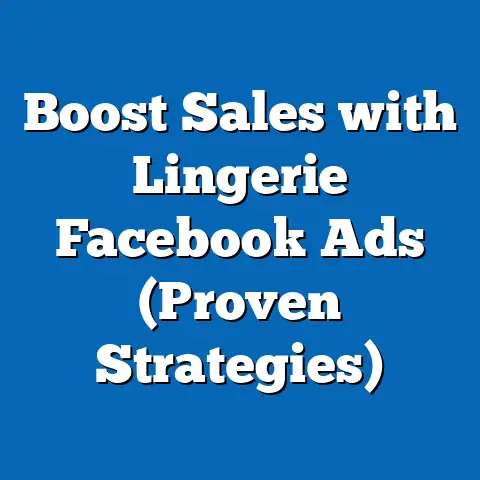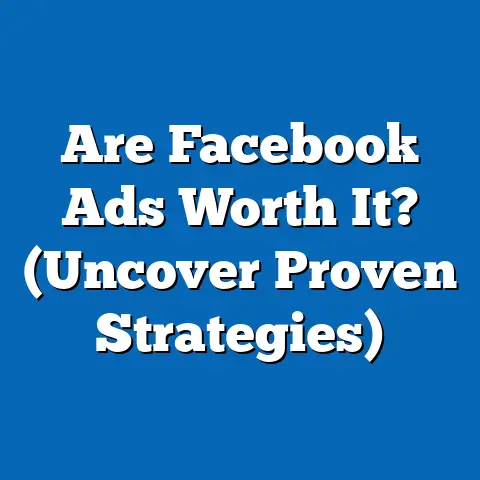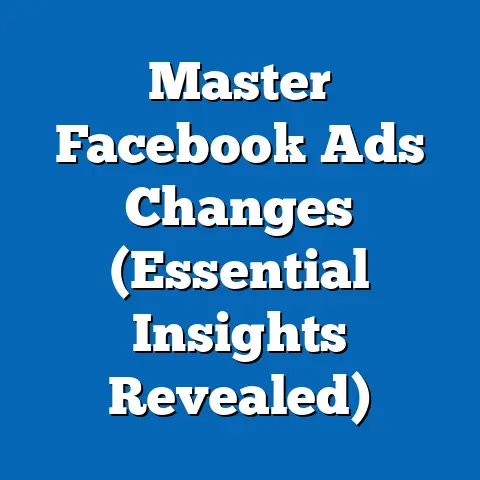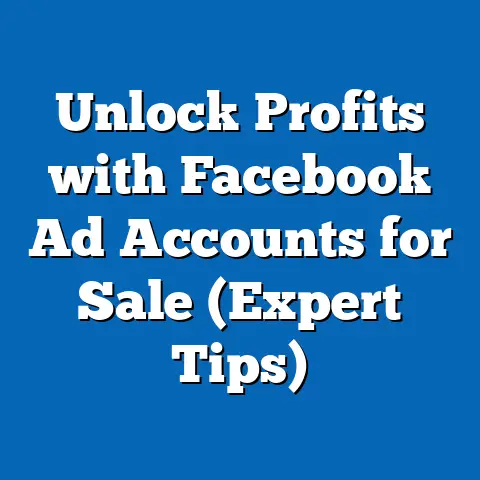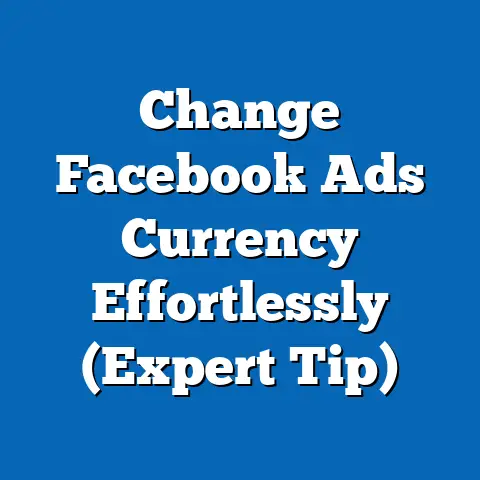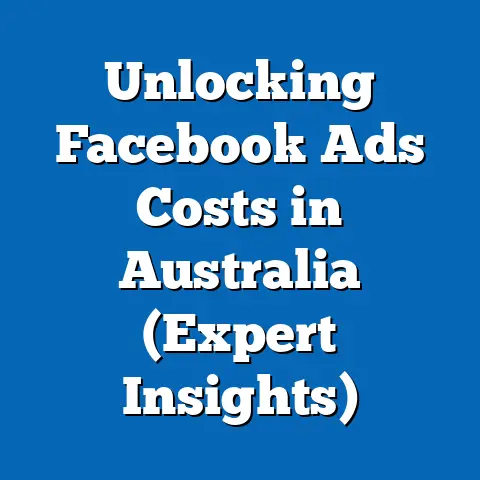Master Facebook Ads: Unlock Proven Strategies (Expert Insights)
In an age where attention spans are dwindling and competition for consumer engagement is fiercer than ever, how do you ensure your Facebook ads not only reach your target audience but also compel them to take action? It’s a question I’ve grappled with for years, and the answer isn’t a simple one. It requires a deep understanding of the platform, a strategic approach to targeting, and a creative touch that resonates with your audience.
Introduction: The Untapped Potential of Facebook Advertising
Facebook, with its staggering 2.8 billion+ monthly active users, remains a powerhouse for businesses of all sizes. I’ve seen small startups explode in growth and established brands revitalize their image, all through the strategic use of Facebook ads. The platform offers an unparalleled opportunity to connect with potential customers, build brand awareness, and drive measurable results. However, simply throwing money at Facebook ads isn’t enough. It requires a mastery of the platform’s intricacies, a data-driven approach, and a willingness to constantly adapt and optimize.
That’s why I’ve created this guide: to share proven strategies for mastering Facebook ads. I’ll be diving into the nitty-gritty details, sharing expert insights, and providing actionable tips that you can implement immediately. Forget the generic advice; we’re going deep, uncovering the secrets to creating Facebook ad campaigns that truly convert.
1. Understanding Facebook Ads: A Landscape Overview
Before we dive into the strategies, let’s make sure we’re all on the same page regarding the Facebook ads landscape. It’s a dynamic environment, constantly evolving with new features and updates. Understanding the basic building blocks is crucial.
-
Ad Formats: Facebook offers a plethora of ad formats to suit various objectives and creative styles.
- Carousel Ads: Great for showcasing multiple products or highlighting different features of a single product. I personally love these for e-commerce clients as they allow for a mini-catalog experience within the ad.
- Video Ads: Capture attention and tell a story. Short, engaging videos tend to perform best. I once ran a video ad for a local restaurant that simply showed mouthwatering shots of their dishes, and the reservations skyrocketed!
- Image Ads: Classic and effective, but require a compelling visual and concise copy.
- Collection Ads: Ideal for e-commerce, allowing users to browse a curated selection of products directly from the ad.
- Lead Ads: Designed to collect lead information directly within Facebook, making it easy for potential customers to sign up for newsletters or request more information.
- Instant Experience Ads: These are full-screen, mobile-optimized ads that load instantly, providing a more immersive experience.
-
Ad Placements: Where your ads appear is just as important as the ad itself.
- Facebook Feed: The most common placement, appearing directly in users’ news feeds.
- Instagram Feed: Leverage the visually-driven nature of Instagram by showcasing stunning images or videos.
- Facebook Stories & Instagram Stories: Perfect for short, engaging content that disappears after 24 hours. I’ve found that story ads are particularly effective for reaching younger audiences.
- Facebook Marketplace: Reach users who are actively looking to buy or sell items.
- Facebook Right Column: A classic placement, but often less effective than feed placements.
- Audience Network: Extend your reach beyond Facebook to a network of mobile apps and websites.
-
Targeting Options: Facebook’s targeting capabilities are what truly set it apart.
- Demographic Targeting: Reach users based on age, gender, location, education, and more.
- Interest-Based Targeting: Target users who have shown interest in specific topics, hobbies, or brands.
- Behavioral Targeting: Reach users based on their online behavior, purchase history, and other activities.
- Custom Audiences: Upload your own customer data (email lists, phone numbers) to target existing customers or create lookalike audiences.
- Lookalike Audiences: Expand your reach by targeting users who share similar characteristics to your existing customers.
-
The Facebook Algorithm: Understanding how Facebook’s algorithm works is crucial for maximizing ad visibility. The algorithm prioritizes content that is relevant and engaging to users. This means that your ads need to be high-quality, targeted, and designed to capture attention. The more engagement your ad receives (likes, comments, shares), the more likely it is to be shown to a wider audience.
Ad Formats: Facebook offers a plethora of ad formats to suit various objectives and creative styles.
- Carousel Ads: Great for showcasing multiple products or highlighting different features of a single product. I personally love these for e-commerce clients as they allow for a mini-catalog experience within the ad.
- Video Ads: Capture attention and tell a story. Short, engaging videos tend to perform best. I once ran a video ad for a local restaurant that simply showed mouthwatering shots of their dishes, and the reservations skyrocketed!
- Image Ads: Classic and effective, but require a compelling visual and concise copy.
- Collection Ads: Ideal for e-commerce, allowing users to browse a curated selection of products directly from the ad.
- Lead Ads: Designed to collect lead information directly within Facebook, making it easy for potential customers to sign up for newsletters or request more information.
- Instant Experience Ads: These are full-screen, mobile-optimized ads that load instantly, providing a more immersive experience.
Ad Placements: Where your ads appear is just as important as the ad itself.
- Facebook Feed: The most common placement, appearing directly in users’ news feeds.
- Instagram Feed: Leverage the visually-driven nature of Instagram by showcasing stunning images or videos.
- Facebook Stories & Instagram Stories: Perfect for short, engaging content that disappears after 24 hours. I’ve found that story ads are particularly effective for reaching younger audiences.
- Facebook Marketplace: Reach users who are actively looking to buy or sell items.
- Facebook Right Column: A classic placement, but often less effective than feed placements.
- Audience Network: Extend your reach beyond Facebook to a network of mobile apps and websites.
Targeting Options: Facebook’s targeting capabilities are what truly set it apart.
- Demographic Targeting: Reach users based on age, gender, location, education, and more.
- Interest-Based Targeting: Target users who have shown interest in specific topics, hobbies, or brands.
- Behavioral Targeting: Reach users based on their online behavior, purchase history, and other activities.
- Custom Audiences: Upload your own customer data (email lists, phone numbers) to target existing customers or create lookalike audiences.
- Lookalike Audiences: Expand your reach by targeting users who share similar characteristics to your existing customers.
The Facebook Algorithm: Understanding how Facebook’s algorithm works is crucial for maximizing ad visibility. The algorithm prioritizes content that is relevant and engaging to users. This means that your ads need to be high-quality, targeted, and designed to capture attention. The more engagement your ad receives (likes, comments, shares), the more likely it is to be shown to a wider audience.
Takeaway: Familiarize yourself with the different ad formats, placements, and targeting options available on Facebook. Experiment with different combinations to see what works best for your business. Don’t underestimate the power of understanding how the Facebook algorithm works.
2. Setting Clear Objectives: The Foundation of Success
Before you even think about creating an ad, you need to define your objectives. What do you want to achieve with your Facebook advertising campaign? Are you looking to increase brand awareness, generate leads, drive sales, or something else entirely?
-
Why Objectives Matter: Without clear objectives, your advertising efforts will be aimless and ineffective. You’ll be wasting money and time without knowing if you’re actually achieving anything. I’ve seen countless businesses launch campaigns without a clear goal, and the results are almost always disappointing.
-
The SMART Criteria: A powerful framework for setting effective objectives is the SMART criteria:
- Specific: Your objective should be clearly defined and focused. Instead of “increase brand awareness,” try “increase brand awareness among women aged 25-34 in the United States.”
- Measurable: You should be able to track your progress and measure the success of your campaign. Use metrics like website traffic, lead generation, or sales.
- Achievable: Set realistic goals that are within your reach. Don’t aim for the impossible.
- Relevant: Your objective should align with your overall business goals.
- Time-bound: Set a deadline for achieving your objective. This will help you stay focused and motivated.
-
Examples of SMART Objectives:
- “Increase website traffic by 20% in the next quarter.”
- “Generate 100 qualified leads in the next month.”
- “Increase sales by 10% during the holiday season.”
- “Reach 50,000 people with our brand message in the next two weeks.”
-
How Objectives Influence Ad Design, Targeting, and Measurement: Your objectives will dictate every aspect of your Facebook advertising campaign.
- Ad Design: If your objective is to generate leads, your ad should include a lead form. If your objective is to drive sales, your ad should showcase your products and include a clear call to action.
- Targeting: Your objectives will help you identify your target audience. If you’re selling women’s clothing, you’ll want to target women. If you’re selling software for small businesses, you’ll want to target small business owners.
- Measurement: Your objectives will determine which metrics you track. If your objective is to increase website traffic, you’ll want to track website clicks and bounce rate. If your objective is to generate leads, you’ll want to track lead conversion rates.
Why Objectives Matter: Without clear objectives, your advertising efforts will be aimless and ineffective. You’ll be wasting money and time without knowing if you’re actually achieving anything. I’ve seen countless businesses launch campaigns without a clear goal, and the results are almost always disappointing.
The SMART Criteria: A powerful framework for setting effective objectives is the SMART criteria:
- Specific: Your objective should be clearly defined and focused. Instead of “increase brand awareness,” try “increase brand awareness among women aged 25-34 in the United States.”
- Measurable: You should be able to track your progress and measure the success of your campaign. Use metrics like website traffic, lead generation, or sales.
- Achievable: Set realistic goals that are within your reach. Don’t aim for the impossible.
- Relevant: Your objective should align with your overall business goals.
- Time-bound: Set a deadline for achieving your objective. This will help you stay focused and motivated.
Examples of SMART Objectives:
- “Increase website traffic by 20% in the next quarter.”
- “Generate 100 qualified leads in the next month.”
- “Increase sales by 10% during the holiday season.”
- “Reach 50,000 people with our brand message in the next two weeks.”
How Objectives Influence Ad Design, Targeting, and Measurement: Your objectives will dictate every aspect of your Facebook advertising campaign.
- Ad Design: If your objective is to generate leads, your ad should include a lead form. If your objective is to drive sales, your ad should showcase your products and include a clear call to action.
- Targeting: Your objectives will help you identify your target audience. If you’re selling women’s clothing, you’ll want to target women. If you’re selling software for small businesses, you’ll want to target small business owners.
- Measurement: Your objectives will determine which metrics you track. If your objective is to increase website traffic, you’ll want to track website clicks and bounce rate. If your objective is to generate leads, you’ll want to track lead conversion rates.
Takeaway: Define your objectives before launching your Facebook advertising campaign. Use the SMART criteria to ensure that your objectives are specific, measurable, achievable, relevant, and time-bound. Let your objectives guide your ad design, targeting, and measurement.
3. Crafting Compelling Ad Creative: Capturing Attention
In the crowded world of social media, your ad creative needs to stand out. It’s the first (and often only) chance you have to grab someone’s attention and persuade them to take action. I’ve spent countless hours analyzing successful ad creatives, and I’ve learned that there are a few key elements that consistently deliver results.
-
Visuals: Images and videos are the most important elements of your ad creative. They’re what people see first, and they’re what will make them stop scrolling.
- High-Quality Images: Use professional-quality images that are visually appealing and relevant to your target audience. Avoid blurry or low-resolution images.
- Engaging Videos: Create short, engaging videos that tell a story and capture attention. Keep your videos under 15 seconds for optimal performance.
- Brand Consistency: Ensure that your visuals are consistent with your brand’s overall aesthetic.
-
Headlines: Your headline is the first piece of text that people will read. It needs to be concise, compelling, and relevant to your target audience.
- Use Strong Verbs: Start your headline with a strong verb to grab attention. Examples include “Discover,” “Learn,” “Get,” and “Try.”
- Highlight Benefits: Focus on the benefits of your product or service, rather than just the features.
- Ask a Question: Asking a question can pique curiosity and encourage people to click on your ad.
-
Call to Action (CTA): Your CTA tells people what you want them to do. It needs to be clear, concise, and action-oriented.
- Use Action Verbs: Start your CTA with an action verb, such as “Shop Now,” “Learn More,” “Sign Up,” or “Download.”
- Create a Sense of Urgency: Use words like “Now” or “Today” to create a sense of urgency and encourage people to take action immediately.
- Make it Prominent: Ensure that your CTA is visually prominent and easy to click.
-
The Psychology Behind Choosing Images and Videos: Certain colors, images, and video styles tend to resonate better with specific audiences. For example, using bright, vibrant colors can be effective for targeting younger audiences, while using more muted tones can be more appropriate for targeting older demographics. I always research color psychology and visual trends before creating ad creatives.
-
A/B Testing: The only way to know for sure what works best is to A/B test different ad creatives. This involves creating multiple versions of your ad with different visuals, headlines, and CTAs, and then running them simultaneously to see which performs best.
- Test One Element at a Time: When A/B testing, it’s important to test only one element at a time. This will allow you to isolate the impact of each element and determine what is driving performance.
- Track Your Results: Use Facebook Ads Manager to track the performance of your different ad creatives. Pay attention to metrics like click-through rate (CTR), conversion rate, and cost per conversion.
-
Examples of Successful Ad Creatives:
- Dollar Shave Club: Their humorous and irreverent video ads went viral, generating millions of views and driving significant sales.
- Airbnb: Their visually stunning image ads showcase unique accommodations around the world, inspiring people to travel.
- Nike: Their motivational video ads feature athletes overcoming challenges, resonating with their target audience and reinforcing their brand message.
Visuals: Images and videos are the most important elements of your ad creative. They’re what people see first, and they’re what will make them stop scrolling.
- High-Quality Images: Use professional-quality images that are visually appealing and relevant to your target audience. Avoid blurry or low-resolution images.
- Engaging Videos: Create short, engaging videos that tell a story and capture attention. Keep your videos under 15 seconds for optimal performance.
- Brand Consistency: Ensure that your visuals are consistent with your brand’s overall aesthetic.
Headlines: Your headline is the first piece of text that people will read. It needs to be concise, compelling, and relevant to your target audience.
- Use Strong Verbs: Start your headline with a strong verb to grab attention. Examples include “Discover,” “Learn,” “Get,” and “Try.”
- Highlight Benefits: Focus on the benefits of your product or service, rather than just the features.
- Ask a Question: Asking a question can pique curiosity and encourage people to click on your ad.
Call to Action (CTA): Your CTA tells people what you want them to do. It needs to be clear, concise, and action-oriented.
- Use Action Verbs: Start your CTA with an action verb, such as “Shop Now,” “Learn More,” “Sign Up,” or “Download.”
- Create a Sense of Urgency: Use words like “Now” or “Today” to create a sense of urgency and encourage people to take action immediately.
- Make it Prominent: Ensure that your CTA is visually prominent and easy to click.
The Psychology Behind Choosing Images and Videos: Certain colors, images, and video styles tend to resonate better with specific audiences. For example, using bright, vibrant colors can be effective for targeting younger audiences, while using more muted tones can be more appropriate for targeting older demographics. I always research color psychology and visual trends before creating ad creatives.
A/B Testing: The only way to know for sure what works best is to A/B test different ad creatives. This involves creating multiple versions of your ad with different visuals, headlines, and CTAs, and then running them simultaneously to see which performs best.
- Test One Element at a Time: When A/B testing, it’s important to test only one element at a time. This will allow you to isolate the impact of each element and determine what is driving performance.
- Track Your Results: Use Facebook Ads Manager to track the performance of your different ad creatives. Pay attention to metrics like click-through rate (CTR), conversion rate, and cost per conversion.
Examples of Successful Ad Creatives:
- Dollar Shave Club: Their humorous and irreverent video ads went viral, generating millions of views and driving significant sales.
- Airbnb: Their visually stunning image ads showcase unique accommodations around the world, inspiring people to travel.
- Nike: Their motivational video ads feature athletes overcoming challenges, resonating with their target audience and reinforcing their brand message.
Takeaway: Invest time and effort into creating compelling ad creatives that capture attention and persuade people to take action. Use high-quality visuals, concise headlines, and clear CTAs. A/B test different ad creatives to see what works best for your target audience.
4. Targeting Your Audience: Reaching the Right People
Even the most compelling ad creative will fail if it’s not shown to the right people. Facebook’s targeting capabilities allow you to reach a highly specific audience based on their demographics, interests, behaviors, and more.
-
Audience Segmentation: The key to effective targeting is audience segmentation. This involves dividing your target audience into smaller groups based on shared characteristics. This allows you to tailor your ad creative and messaging to each group, making it more relevant and engaging.
- Demographic Segmentation: Segment your audience based on age, gender, location, education, and more.
- Interest-Based Segmentation: Segment your audience based on their interests, hobbies, and passions.
- Behavioral Segmentation: Segment your audience based on their online behavior, purchase history, and other activities.
-
Custom Audiences: Custom audiences allow you to target your existing customers or website visitors.
- Customer Lists: Upload your customer email list or phone numbers to target your existing customers on Facebook. This is a great way to promote new products or services to your loyal customers.
- Website Visitors: Install the Facebook Pixel on your website to track your website visitors and target them with relevant ads. This is a powerful way to re-engage people who have shown interest in your products or services.
- Engagement Audiences: Target people who have interacted with your Facebook page or ads. This is a great way to build relationships with your most engaged fans.
-
Lookalike Audiences: Lookalike audiences allow you to expand your reach by targeting people who share similar characteristics to your existing customers.
- Seed Audience: You can create a lookalike audience based on your customer list, website visitors, or engagement audience.
- Similarity Percentage: You can choose the similarity percentage for your lookalike audience. A higher percentage will result in a smaller, more similar audience, while a lower percentage will result in a larger, less similar audience.
-
Facebook Insights: Facebook Insights provides valuable data about your audience, including their demographics, interests, and behaviors. Use this data to refine your targeting and improve the performance of your ads.
- Page Insights: Learn about the demographics, interests, and behaviors of your Facebook page fans.
- Ad Insights: Track the performance of your Facebook ads and identify areas for improvement.
Audience Segmentation: The key to effective targeting is audience segmentation. This involves dividing your target audience into smaller groups based on shared characteristics. This allows you to tailor your ad creative and messaging to each group, making it more relevant and engaging.
- Demographic Segmentation: Segment your audience based on age, gender, location, education, and more.
- Interest-Based Segmentation: Segment your audience based on their interests, hobbies, and passions.
- Behavioral Segmentation: Segment your audience based on their online behavior, purchase history, and other activities.
Custom Audiences: Custom audiences allow you to target your existing customers or website visitors.
- Customer Lists: Upload your customer email list or phone numbers to target your existing customers on Facebook. This is a great way to promote new products or services to your loyal customers.
- Website Visitors: Install the Facebook Pixel on your website to track your website visitors and target them with relevant ads. This is a powerful way to re-engage people who have shown interest in your products or services.
- Engagement Audiences: Target people who have interacted with your Facebook page or ads. This is a great way to build relationships with your most engaged fans.
Lookalike Audiences: Lookalike audiences allow you to expand your reach by targeting people who share similar characteristics to your existing customers.
- Seed Audience: You can create a lookalike audience based on your customer list, website visitors, or engagement audience.
- Similarity Percentage: You can choose the similarity percentage for your lookalike audience. A higher percentage will result in a smaller, more similar audience, while a lower percentage will result in a larger, less similar audience.
Facebook Insights: Facebook Insights provides valuable data about your audience, including their demographics, interests, and behaviors. Use this data to refine your targeting and improve the performance of your ads.
- Page Insights: Learn about the demographics, interests, and behaviors of your Facebook page fans.
- Ad Insights: Track the performance of your Facebook ads and identify areas for improvement.
Takeaway: Leverage Facebook’s targeting capabilities to reach the right people with your ads. Segment your audience based on shared characteristics, create custom audiences to target your existing customers, and use lookalike audiences to expand your reach. Use Facebook Insights to refine your targeting and improve the performance of your ads.
5. Budgeting and Bidding Strategies: Maximizing ROI
Managing your budget and bidding strategies effectively is crucial for maximizing your return on investment (ROI). You need to ensure that you’re spending your money wisely and getting the most bang for your buck.
-
Budgeting Options: Facebook offers two main budgeting options:
- Daily Budget: Set a daily budget for each ad set. This is the average amount you’ll spend per day.
- Lifetime Budget: Set a total budget for the entire campaign. Facebook will automatically distribute your budget over the duration of the campaign.
-
Choosing the Right Budgeting Option: The best budgeting option for you will depend on your campaign goals and your budget.
- Daily Budget: Ideal for ongoing campaigns where you want to maintain a consistent level of spending.
- Lifetime Budget: Ideal for campaigns with a specific end date, such as promotions or events.
-
Bidding Strategies: Facebook offers several bidding strategies:
- Cost Per Click (CPC): You pay each time someone clicks on your ad.
- Cost Per Thousand Impressions (CPM): You pay for every 1,000 times your ad is shown.
- Cost Per Action (CPA): You pay only when someone takes a specific action, such as making a purchase or filling out a lead form.
-
Choosing the Right Bidding Strategy: The best bidding strategy for you will depend on your campaign goals and your budget.
- CPC: Ideal for driving traffic to your website.
- CPM: Ideal for increasing brand awareness.
- CPA: Ideal for generating leads or driving sales.
-
Optimizing Budget Allocation: It’s important to monitor your ad performance and adjust your budget allocation accordingly. If one ad set is performing better than another, you should allocate more budget to the higher-performing ad set.
Budgeting Options: Facebook offers two main budgeting options:
- Daily Budget: Set a daily budget for each ad set. This is the average amount you’ll spend per day.
- Lifetime Budget: Set a total budget for the entire campaign. Facebook will automatically distribute your budget over the duration of the campaign.
Choosing the Right Budgeting Option: The best budgeting option for you will depend on your campaign goals and your budget.
- Daily Budget: Ideal for ongoing campaigns where you want to maintain a consistent level of spending.
- Lifetime Budget: Ideal for campaigns with a specific end date, such as promotions or events.
Bidding Strategies: Facebook offers several bidding strategies:
- Cost Per Click (CPC): You pay each time someone clicks on your ad.
- Cost Per Thousand Impressions (CPM): You pay for every 1,000 times your ad is shown.
- Cost Per Action (CPA): You pay only when someone takes a specific action, such as making a purchase or filling out a lead form.
Choosing the Right Bidding Strategy: The best bidding strategy for you will depend on your campaign goals and your budget.
- CPC: Ideal for driving traffic to your website.
- CPM: Ideal for increasing brand awareness.
- CPA: Ideal for generating leads or driving sales.
Optimizing Budget Allocation: It’s important to monitor your ad performance and adjust your budget allocation accordingly. If one ad set is performing better than another, you should allocate more budget to the higher-performing ad set.
Takeaway: Choose the right budgeting option and bidding strategy for your campaign goals. Monitor your ad performance and adjust your budget allocation accordingly to maximize your ROI.
6. Analyzing Performance and Metrics: Data-Driven Decisions
Analyzing your ad performance is essential for making informed decisions and optimizing your campaigns. By tracking key performance indicators (KPIs), you can identify what’s working and what’s not, and make adjustments to improve your results.
-
Key Performance Indicators (KPIs):
- Click-Through Rate (CTR): The percentage of people who click on your ad after seeing it. A high CTR indicates that your ad is relevant and engaging to your target audience.
- Conversion Rate: The percentage of people who take a desired action after clicking on your ad, such as making a purchase or filling out a lead form. A high conversion rate indicates that your landing page is effective and your offer is compelling.
- Return on Ad Spend (ROAS): The amount of revenue you generate for every dollar you spend on advertising. A high ROAS indicates that your advertising campaigns are profitable.
- Engagement Metrics: Metrics such as likes, comments, shares, and video views can provide insights into how people are interacting with your ads.
-
Using Facebook Ads Manager: Facebook Ads Manager provides a comprehensive dashboard for tracking and analyzing your ad performance. You can use it to view your KPIs, track your budget, and make adjustments to your campaigns.
-
Interpreting Data: It’s important to understand how to interpret the data you’re seeing in Facebook Ads Manager. For example, if your CTR is low, it may indicate that your ad creative is not compelling or your targeting is not accurate. If your conversion rate is low, it may indicate that your landing page is not effective or your offer is not compelling.
Key Performance Indicators (KPIs):
- Click-Through Rate (CTR): The percentage of people who click on your ad after seeing it. A high CTR indicates that your ad is relevant and engaging to your target audience.
- Conversion Rate: The percentage of people who take a desired action after clicking on your ad, such as making a purchase or filling out a lead form. A high conversion rate indicates that your landing page is effective and your offer is compelling.
- Return on Ad Spend (ROAS): The amount of revenue you generate for every dollar you spend on advertising. A high ROAS indicates that your advertising campaigns are profitable.
- Engagement Metrics: Metrics such as likes, comments, shares, and video views can provide insights into how people are interacting with your ads.
Using Facebook Ads Manager: Facebook Ads Manager provides a comprehensive dashboard for tracking and analyzing your ad performance. You can use it to view your KPIs, track your budget, and make adjustments to your campaigns.
Interpreting Data: It’s important to understand how to interpret the data you’re seeing in Facebook Ads Manager. For example, if your CTR is low, it may indicate that your ad creative is not compelling or your targeting is not accurate. If your conversion rate is low, it may indicate that your landing page is not effective or your offer is not compelling.
Takeaway: Track your KPIs, use Facebook Ads Manager to analyze your ad performance, and interpret the data to make informed decisions for future campaigns.
Conclusion: Unlock Your Advertising Potential
Mastering Facebook ads is an ongoing process. It requires a willingness to learn, experiment, and adapt to the ever-changing landscape of social media advertising. By implementing the strategies discussed in this article, you can unlock your advertising potential and drive significant business growth. Remember to set clear objectives, craft compelling ad creatives, target your audience effectively, manage your budget wisely, and analyze your performance regularly.
I’ve seen firsthand the transformative power of Facebook advertising when done right. It’s not just about running ads; it’s about building relationships, connecting with your audience on a deeper level, and creating a brand experience that resonates. So, take these strategies, put them into action, and watch your business thrive. The potential is there; it’s up to you to unlock it.

